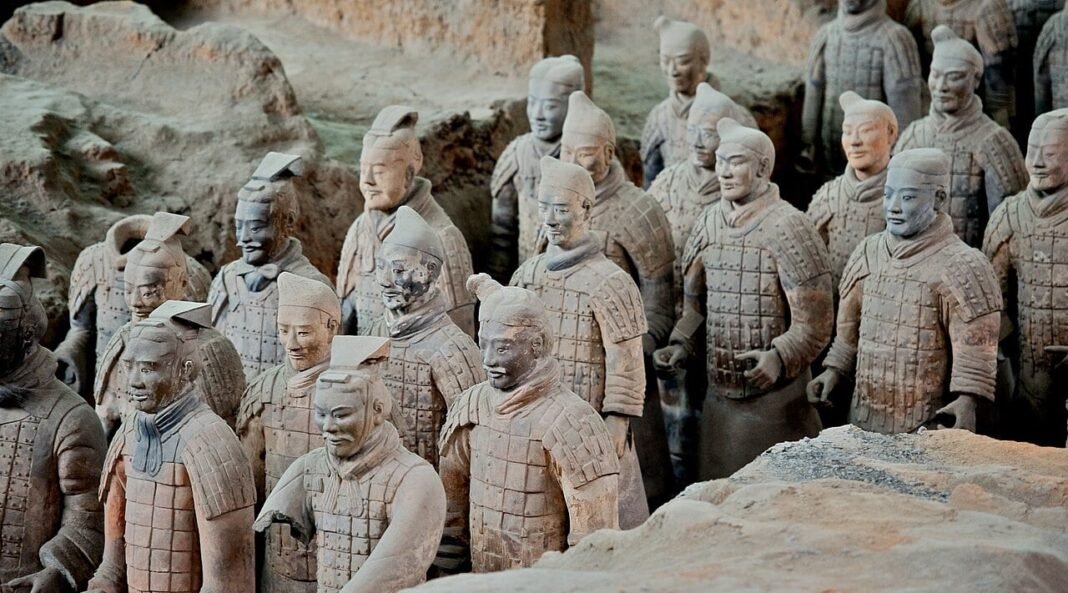
Qin Shi Huang, the first emperor of a unified China, lies beneath a grassy mound east of Xi’an, a site that looks almost modest until you consider what is rumored to rest inside. Evidence suggests it conceals an entire buried city, complete with administrative, ceremonial, and landscaped elements, all designed to extend the Chinese imperial order into the afterlife.
Most people have probably heard of the famous Terracotta Army, the greeting card of the entire necropolis. However, to understand why the central tomb has not yet been opened, we must consider three things: what the archaeological evidence actually shows, how vast the mausoleum truly is, and what archaeological conservation has taught us—often painfully—about revealing treasures too soon.
Qin Shi Huang (259–210 BC) unified the warring Chinese states in 221 BC, founded the Qin dynasty, standardized currency, script, and weights and measures, and imposed a centralized legalist state that reshaped East Asia forever. His short-lived dynasty (221–206 BC) built vast infrastructure and began the early linkages of the Great Wall but ruled with exceptional harshness, leading to multiple rebellions after his death.

What we really know about China’s first emperor’s tomb: Qin Shi Huang
Qin Shi Huang, China’s first emperor, has inspired legends that stretch across millennia, and one of the most influential historians, Sima Qian, revealed the cinematic details of his necropolis: rivers of mercury flowing around a palace beneath the earth, crossbows ready to strike any intruder, and elaborate artifices befitting a ruler regarded as a god-king.
Modern archaeology has confirmed some of these accounts while tempering others. Elevated mercury levels have been detected in the soil and air near the heart of the mound, consistent with the idea of a symbolic “ocean” in the underworld. Still, numbers alone cannot tell us whether actual pools of liquid metal remain or if this is an exaggeration.
Thousands of bronze crossbow triggers and other weapon components have been excavated across the complex, confirming the enormous scale of armament included during the construction of this monumental burial site. What has not been found, however, is a verified, functioning trap for intruders. Wood decays, cords lose tension, and mechanical devices degrade over time, leaving no clear, scientifically proven evidence. For now, it remains a mystery. The army pits, familiar to millions of visitors, occupy only a tiny fraction of the entire protected zone—far less than a tenth of one percent of the whole area.
The mausoleum is arranged like a miniature capital city: inner and outer walls, processional paths, and a constellation of satellite pits. Some contained officials and grooms, while others housed acrobats or musicians. One pit yielded a collection of stone armor plates mimicking lamellar suits. Another held cast bronze waterfowl arranged beside a sculpted “pond,” a quiet scene from a long-vanished garden. To the west of the mound, two bronze chariots—true masterpieces in miniature—reveal intricate details of Ancient Chinese society.
Taken together, these discoveries illuminate the logistics, spectacle, and surveillance methods utilized by Ancient Chinese administrations.

Why China refuses to excavate the entire site
The short answer to this million-dollar question is ethics and technology. The longer answer, however, involves experience and learning from past mistakes. When the first Terracotta figures were exposed to fresh air several decades ago, their lacquer underlayers and bright pigments began flaking within hours. Only later did conservators develop rapid, on-site stabilization methods to slow the loss. That early shock left a lasting impression on the international archaeological community.
Today, excavation teams rely on micro-excavation techniques, climate-controlled enclosures built directly over trenches, consolidants tailored for fragile organics, and a battery of non-invasive surveys, including ground-penetrating radar, magnetometry, and high-resolution 3D mapping. Remote sensing has already revealed what appear to be corridors and chambers, allowing archaeologists to know what exists without putting it at risk.
As a result, the “do no harm” approach has become official policy in China and standard practice internationally. The debate is no longer “What marvels could we reveal?” but rather, “What can we reveal while ensuring it survives for centuries afterward?” Until that question can be confidently answered, China’s decision to keep the entire site sealed off remains firm.

The mercury problem
If the chamber is ever opened, mercury presents both a scientific challenge and a media magnet. Elevated background levels mean that risk management will be essential: archaeologists and workers will need proper containment barriers, negative-pressure enclosures, filtration systems, and remediation plans to protect both personnel and the surrounding environment.
Historical records indicate disturbances during Han times, and some areas still bear the remnants of later looting. Yet key sectors remain remarkably intact, making the necropolis all the more intriguing.
It’s tempting to draw analogies with other famous burial sites: Tutankhamun’s small, rock-cut tomb, sealed like a time capsule; Pakal’s sarcophagus within a stepped pyramid; the freestanding Mausoleum at Halicarnassus; or the tomb of Philip of Macedon in Greece’s Vergina—all examples dominated by architecture rather than earthwork. Qin Shi Huang’s necropolis is none of these. Its scale, complexity, and integration with the surrounding landscape set it apart entirely.

The necropolis is far grander in ambition, broader in planning, and riskier in conservation terms. Archaeologists must consider the entire landscape, not just a few rooms. Open one door, and the chemistry and mechanics of hundreds of others could be affected. That’s why stewardship must balance scholarship, tourism, and community interests, making it easy to see why the debate remains lively within China’s archaeological community.
When does opening a chamber cross the line from justified to reckless? Who sets the standard for “enough technology”? This grandest of ancient burial complexes forces us to find the right balance—or risk destroying one of the world’s most important, if not the most important, archaeological sites.


